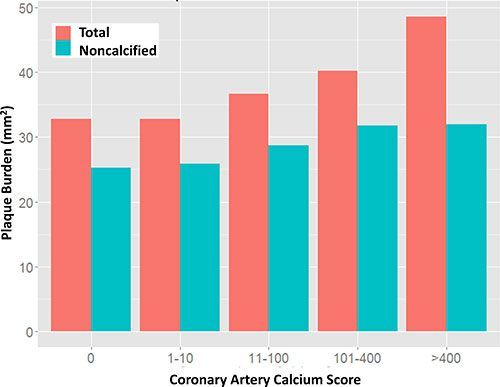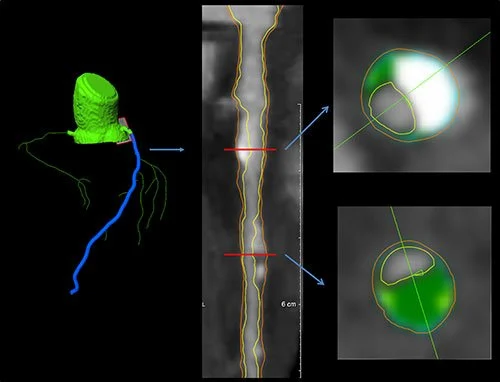Results of a new study published in Radiology reveal that non-calcified arterial plaque is associated with diabetes, high systolic blood pressure and increased “bad” cholesterol levels in asymptomatic individuals.
“Most information to date about coronary artery disease and cardiovascular risk factors in asymptomatic individuals has been derived from calcium scoring,” says lead author, David A. Bluemke, MD, PhD, from the NIH Clinical Center. “We hypothesised that risk factors for the presence of non-calcified plaque may differ from those for calcified plaque.”
Coronary artery calcium (CAC) scoring with CT, a common noninvasive technique, measures how much calcified plaque a person has. However, CAC does not measure non-calcified plaque, the component that tends to be dangerous. Despite treatment for hypercholesterolemia (high levels of cholesterol in the blood), CAC scores often paradoxically increase.
Coronary computed tomography angiography (CCTA) has emerged as a viable screening option for plaque, including non-calcified plaque. CCTA can capture the full anatomic map of the coronary arteries in a single heartbeat with low radiation dose and provide a complete picture of the total amount of plaque throughout the arteries of the heart.
For the study, Dr. Bluemke's team used CCTA to assess the relationship between calcified and non-calcified coronary plaque burden in the coronary arteries and cardiovascular risk factors in low- to moderate-risk asymptomatic individuals. The team recruited 202 asymptomatic men and women over age 55 who were eligible for statin therapy. CCTA was performed using a 320-detector row CT scanner and an intravenous contrast agent. Coronary wall thickness/plaque was evaluated, and analysis was performed to determine the relationship between risk factors and plaque.
After controlling for all risk factors, the researchers found that total coronary plaque index was greater in men than in women. Interestingly, non-calcified plaque index was significantly associated with greater systolic blood pressure, diabetes, and elevated low-density lipoprotein (LDL) cholesterol level.
“These results highlight the potential of CCTA in quantifying plaque burden to assess progression or regression of coronary artery disease in low- to moderate-risk individuals,” Dr. Bluemke points out.
Top image. Images in 62-year-old man. Left: Coronary segmentation model of the coronary tree. Middle: A curved multiplanar reconstruction of the left anterior descending artery, with the lumen and external vessel walls marked. Right: Representative cross-sectional images, with green shading = noncalcified plaque.

Figure 1. Graph shows total and noncalcified plaque composition (in square millimetres) as a function of CAC score. For very high CAC scores (˃400), noncalcified plaque was approximately 67 percent of the total plaque index. For lower plaque scores (11–100), noncalcified plaque was approximately 82 percent of the total plaque index.
Source and image credit: Radiological Society of North America
“Most information to date about coronary artery disease and cardiovascular risk factors in asymptomatic individuals has been derived from calcium scoring,” says lead author, David A. Bluemke, MD, PhD, from the NIH Clinical Center. “We hypothesised that risk factors for the presence of non-calcified plaque may differ from those for calcified plaque.”
Coronary artery calcium (CAC) scoring with CT, a common noninvasive technique, measures how much calcified plaque a person has. However, CAC does not measure non-calcified plaque, the component that tends to be dangerous. Despite treatment for hypercholesterolemia (high levels of cholesterol in the blood), CAC scores often paradoxically increase.
Coronary computed tomography angiography (CCTA) has emerged as a viable screening option for plaque, including non-calcified plaque. CCTA can capture the full anatomic map of the coronary arteries in a single heartbeat with low radiation dose and provide a complete picture of the total amount of plaque throughout the arteries of the heart.
For the study, Dr. Bluemke's team used CCTA to assess the relationship between calcified and non-calcified coronary plaque burden in the coronary arteries and cardiovascular risk factors in low- to moderate-risk asymptomatic individuals. The team recruited 202 asymptomatic men and women over age 55 who were eligible for statin therapy. CCTA was performed using a 320-detector row CT scanner and an intravenous contrast agent. Coronary wall thickness/plaque was evaluated, and analysis was performed to determine the relationship between risk factors and plaque.
After controlling for all risk factors, the researchers found that total coronary plaque index was greater in men than in women. Interestingly, non-calcified plaque index was significantly associated with greater systolic blood pressure, diabetes, and elevated low-density lipoprotein (LDL) cholesterol level.
“These results highlight the potential of CCTA in quantifying plaque burden to assess progression or regression of coronary artery disease in low- to moderate-risk individuals,” Dr. Bluemke points out.
Top image. Images in 62-year-old man. Left: Coronary segmentation model of the coronary tree. Middle: A curved multiplanar reconstruction of the left anterior descending artery, with the lumen and external vessel walls marked. Right: Representative cross-sectional images, with green shading = noncalcified plaque.

Figure 1. Graph shows total and noncalcified plaque composition (in square millimetres) as a function of CAC score. For very high CAC scores (˃400), noncalcified plaque was approximately 67 percent of the total plaque index. For lower plaque scores (11–100), noncalcified plaque was approximately 82 percent of the total plaque index.
Source and image credit: Radiological Society of North America
Latest Articles
healthmanagement, coronary artery disease, arterial plaque, cholesterol, diabetes, blood pressure
Results of a new study published in Radiology reveal that non-calcified arterial plaque is associated with diabetes, high systolic blood pressure and increased “bad” cholesterol levels in asymptomatic individuals.










